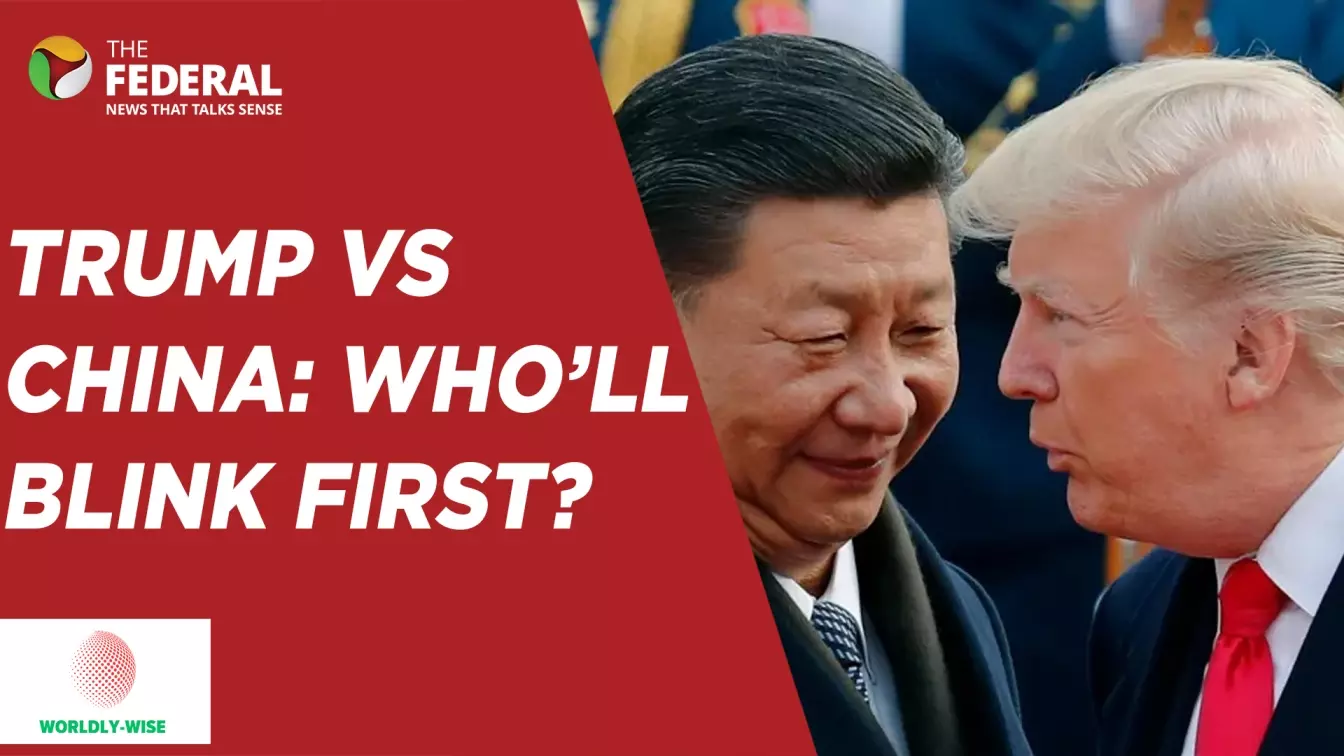
In this episode of Worldly-Wise, The Federal's Managing Editor KS Dakshina Murthy explores what prompted the tariff spike, China’s firm retaliation, and the complex history and economic interdependence between the two powers.
Trump’s China tariff war: Has he bitten off more than he can chew?
Trump slaps 145 pc tariffs on China, hoping to restore US manufacturing. Can he win this risky battle?

Former US President Donald Trump has imposed a hefty 145 per cent tariff on imports from China, while sparing other countries with a limited 10 per cent tariff for 90 days. The move signals a renewed trade offensive against Beijing, reigniting a bitter economic rivalry that could reshape the global trade landscape.
In this episode of Worldly-Wise, The Federal's Managing Editor KS Dakshina Murthy explores what prompted the tariff spike, China’s firm retaliation, and the complex history and economic interdependence between the two powers.
China the real target
While Trump claims to review tariffs after pleas from global leaders - whom he crudely said were “kissing my you-know-what” - it’s clear that China was the primary target from the outset. The Xi Jinping-led government swiftly responded by slapping its own retaliatory tariffs on the US, now standing at 84 per cent.
Also Read: Xi urges EU to join hands to counter Trump’s 'unilateral tariff bullying'
Notably, China is the only country that refused to seek a rollback from Trump.
“What is it about China that makes it confident enough to take on the US shoulder-to-shoulder without flinching?” asks Dakshina Murthy.
Contradictory relationship
Despite rising tensions, China and the US remain deeply intertwined. They are each other’s largest trading partners, with trade volume reaching $700 billion last year. Since restoring diplomatic ties in 1979, bilateral trade has surged 280 times.
The irony runs deep - China’s transformation into a manufacturing powerhouse is largely due to US offshoring in the 1990s. American firms, attracted by China’s infrastructure and low-cost skilled labour, shifted operations eastward, inadvertently fuelling China’s rise.
Mutual dependence
In September 2008, China overtook Japan as the largest holder of US treasury bonds, becoming a key financial lifeline during the economic crash. Yet today, the US and China are not just collaborators - they are also each other’s greatest strategic rivals.
Also Read: Trump tariffs spark Chinese meme wave on TikTok, other platforms
Analysts describe the relationship as akin to “conjoined Siamese twins,” joined at the hips - simultaneously co-dependent and competitive.
History and irony
China’s might is far from new. Between the 9th and 15th centuries, it led global industry, with large-scale factories and water-powered machines for textiles and paper long before the West.
“Iron production touched 250 million tons by the 11th century,” notes Dakshina Murthy.
Colonialism and the opium wars in the 19th century crippled China, but the nation rebounded through a communist revolution and modern reforms. The US played an unintentional role in China’s 20th-century revival, allowing it to evolve into the economic force it is today.
Trade workaround strategy
To bypass US tariffs, China has set up global manufacturing hubs - in Brazil, Mexico, Vietnam, and more. These satellite units assemble goods using Chinese components, allowing them to avoid “Made in China” labelling and hence US tariffs.
Also Read: What prompted Trump’s 90-day pause on higher tariffs for most nations
To counter this, Trump has widened the net, applying reciprocal tariffs on all countries. Yet, Chinese components still reach US shores through these indirect channels, sustaining China’s trade surplus.
Uncertain future
“This is the equivalent of Trump standing with a water hose, trying to put out the recent California wildfires,” says Dakshina Murthy.
The complexity of global supply chains and China’s economic scale make it near impossible to isolate.
Also Read: China retaliates with 125 per cent tariffs against US imports
As other countries also struggle with surging Chinese imports affecting domestic manufacturing, they may support US efforts to counterbalance Beijing’s dominance. But the world may be heading towards a turbulent phase of medium-term economic instability.
(The content above has been generated using a fine-tuned AI model. To ensure accuracy, quality, and editorial integrity, we employ a Human-In-The-Loop (HITL) process. While AI assists in creating the initial draft, our experienced editorial team carefully reviews, edits, and refines the content before publication. At The Federal, we combine the efficiency of AI with the expertise of human editors to deliver reliable and insightful journalism.)

